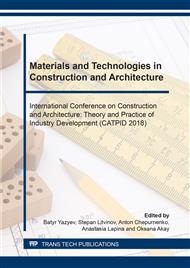[1]
V.Yu. Alpatov, On the use of the criterion energy efficiency, in optimization of the constructive form of spatial lattice structures, in: Traditions and innovations in construction and architecture. Construction, Samara, 2011, pp.879-880.
Google Scholar
[2]
V.Yu. Alpatov, Lukin A.A., The method of mirror functions in optimal design of pre-stressed spatial structures, Procedia Engineering. 111 (2015) 20-29.
DOI: 10.1016/j.proeng.2015.07.030
Google Scholar
[3]
V.Yu. Alpatov, S. Petrov, Energy efficient three-layer panels and elastic compliance of their middle layer, MATEC Web Conf. 106 (2017) 04002.
DOI: 10.1051/matecconf/201710604002
Google Scholar
[4]
O.Ya. Kokorin, A.S. 491016 (USSR) Regenerative heat exchanger, B.I., 41 (1973).
Google Scholar
[5]
Decentralized ventilation Swegon RU-Dec-Vent. Information on http://www.swegon.com.
Google Scholar
[6]
Household ventilation of high comfort with heat recovery, Meltem Wärmerückgewinnung GmbH&Co. KG. Information on http://www.dezentral.info.
Google Scholar
[7]
The art of air management, Troks RUS Ltd, Moscow, (2010).
Google Scholar
[8]
Wall-mounted supply and exhaus ventilation unit with recuperator Mitsubishi Electric LossnayVL-100EU5-E, Moscow office of the company Mitsubishi Electric, Moscow, (2014).
Google Scholar
[9]
Controlled ventilation of apartments, Lunos ventilation technique, Berlin, (2010).
Google Scholar
[10]
O.Ya. Kokorin, Modern air conditioning systems, Izdatelstvo fiziko-matematicheskoy literatury, Moscow, (2003).
Google Scholar
[11]
Supply and exhaust ventilation unit with heat recovery UVRK-50, Technical passport of the product, Omsk, (2010).
Google Scholar
[12]
Decentralized through-flow supply and exhaust ventilation system (industrial-household) Prana, Technical passport of the product, Lvov, (2012).
Google Scholar
[13]
V.G. Baron, Heat recuperator of the ventilation air–energy efficiency or unjustified expence, Heating news. 1 (2007) 43-47.
Google Scholar
[14]
V.G. Baron, On thermal efficiency of decentralized heat recuperators of ventilation air, Energy saving. 2 (2007) 41-44.
Google Scholar
[15]
Thin-wall heat exchanger HPAIv «TeFo», Technical passport of the product, Sevastopol, (2007).
Google Scholar
[16]
A.L. Luks, E.A. Krestin, A.G. Matveev, V.I. Vesnin, Experimental study of operation modes of high-efficiency heat pipes with a Ω-shaped fossulate, Town-planning and architecture. 3 (2016) 17-29.
DOI: 10.17673/vestnik.2016.03.3
Google Scholar
[17]
R.Sh. Mansurov, A.B. Kostuganov, A.R. Mansurov, in: Innovative technologies for providing microclimate of premises, in: International scientific and technical conference «Innovative building technologies, theory and practice», Orenburg, 2013, pp.121-126.
Google Scholar


